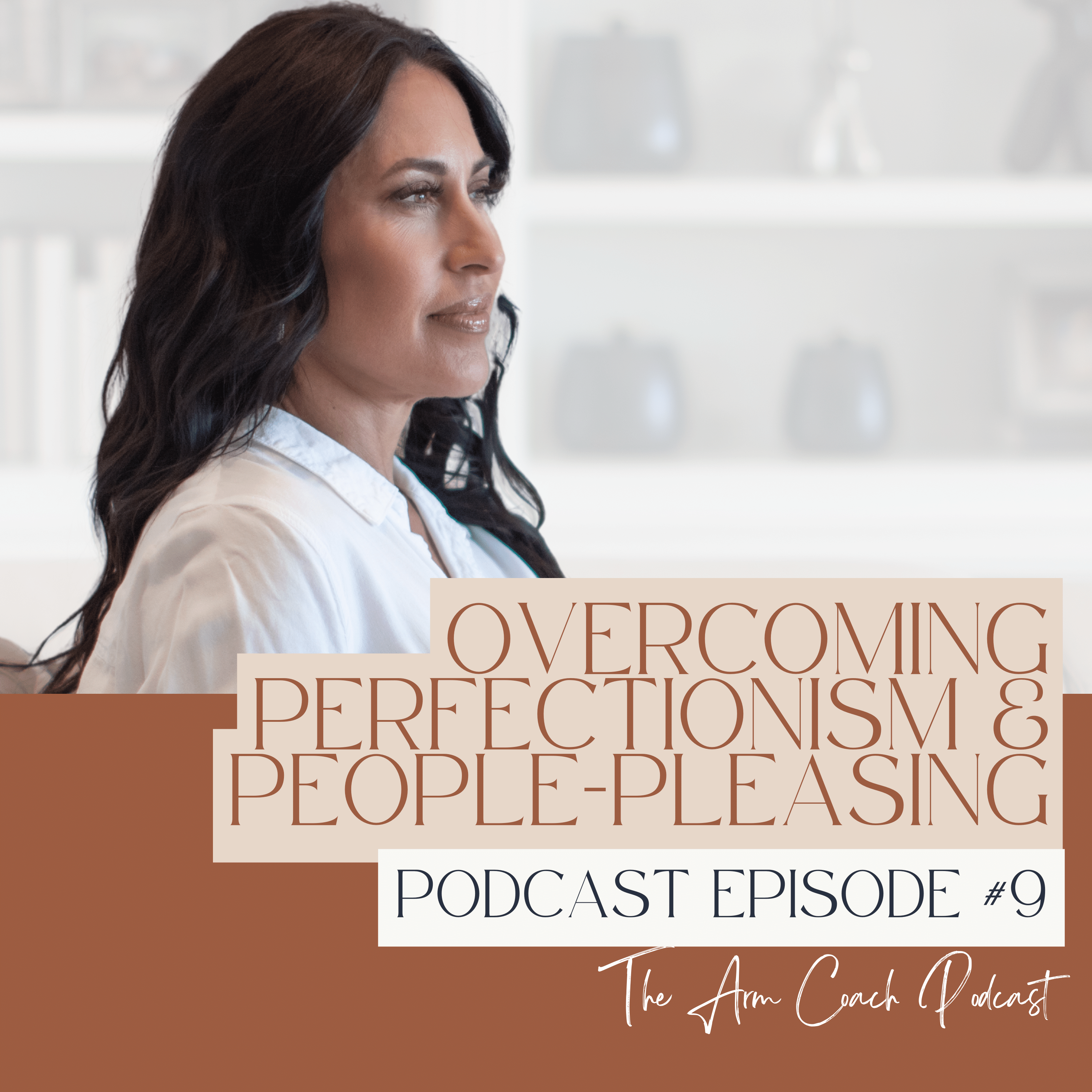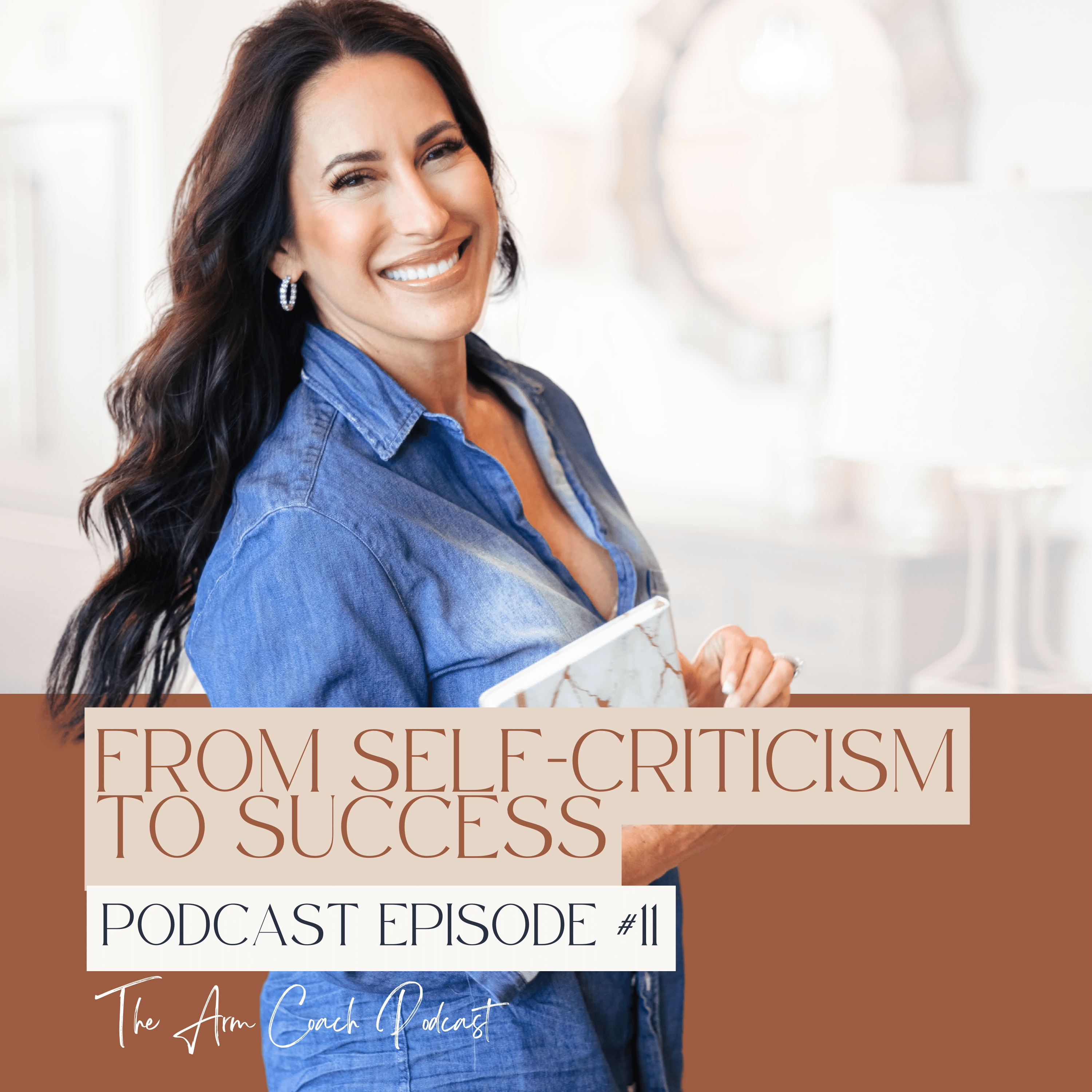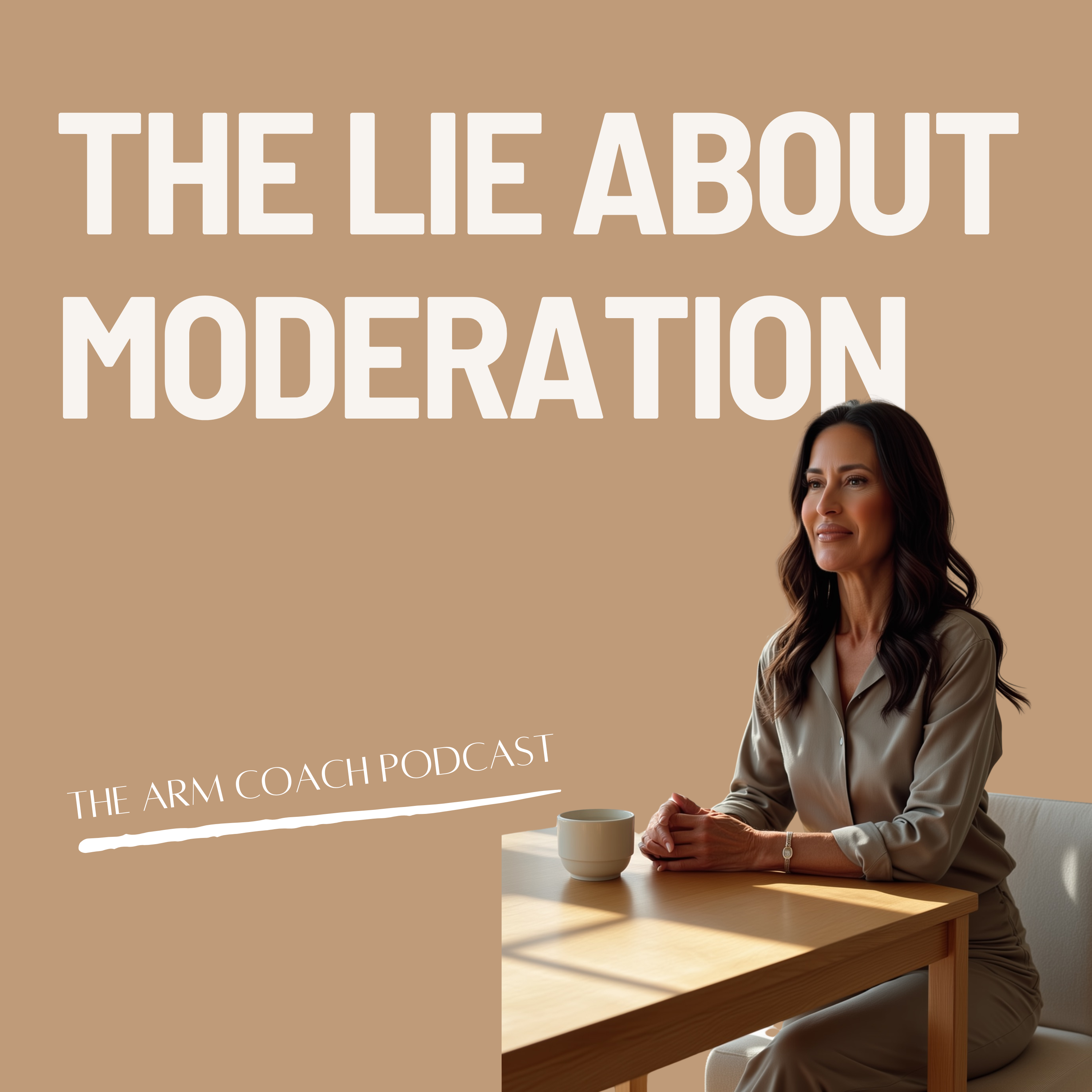Episode Transcript
Like so many people, you
might believe that it’s just
not possible for you to
tone your arms. This is
just who you are, and
there’s no changing that.
This is false.
You are 100 percent
capable of changing your
arms, but first, you have
to believe it’s possible.
Today, learn how to start
developing that belief in
your ability to change.
Hey Everyone! Welcome
back to The Arm Coach
Podcast,
episode 42! I absolutely
love hosting this podcast
where I believe we’re
redefining what it means
to tone your arms and
transform your life. So if
you’re a woman who’s
ready to embrace change
and build not just
strength, but the mental
tools to thrive in every
area of your life, Listen,
you’re in the right place.
Today, we’re diving deep
into one of the most
important topics when it
comes to transformation:
believing in your ability
to change.
Here’s the thing: toning your
arms isn’t just about
aesthetics or lifting weights.
It’s about developing the
confidence, discipline, and
mindset to say, “I can.”
Think of it like learning to
ride a bike—at first, it feels
wobbly, awkward, and
uncertain, but as you
practice, that balance
becomes second nature. And
suddenly, you’re not just
riding a bike; you’re feeling
free, empowered, and
unstoppable. That shift? It
can ripple out into
everything you do—from
how you show up for your
family, to how you tackle
your goals, to how you feel
about yourself every single
day.
So let’s get into it.
I want to start with a
powerful idea: giving
yourself the gift of a new
thought. A lot of people
come to me and ask, “Do
you really think I can change
at my age? Do you really
think I can tone my arms,
feel strong, and finally feel
good about my body?” And
my answer is always this:
Yes, you can. It doesn’t
matter who you are, how old
you are, or how many times
you’ve tried before. Change
is always possible.
Let me bring this to life—a
story some of you may relate
to. I once worked with a
woman who had spent years
telling herself, “This is just
how I’m built. Strong, toned
arms? That’s for other
women, not me.” Her belief
was reinforced by decades of
messaging that told her that
women over 50 couldn’t
transform their bodies—that
by a certain age, it’s all
downhill. Even her friends
would say things like, “Why
bother? Just accept it and
focus on other things.”
But she didn’t want to accept
it. Deep down, she felt a
spark of possibility, even
though society—and her
inner critic—kept trying to
snuff it out. So, she made the
bold decision to give herself
the gift of a new thought:
“What if they’re wrong?”
That single shift sparked a
domino effect. She didn’t
just start working on her
arms; she started working on
her mindset, questioning
every limiting belief she had
about her age, her body, and
her potential.
Now, here’s the part that
made people uncomfortable:
as she started transforming
—both physically and
mentally—those same
friends who told her it was
impossible began to feel
uneasy. Instead of
celebrating her success, they
said things like, “You’re
obsessed,” or, “Why do you
care so much about your
arms?” But the truth was, it
wasn’t about the arms. It
was about proving to herself
that she was capable of
change.
That’s the point I want you
to take away. Yes, this idea
makes people
uncomfortable. Yes, it
challenges deeply ingrained
beliefs. But the real
discomfort isn’t about you
changing—it’s about others
confronting their own
limiting beliefs. And here’s
my response to anyone who
questions it: I believe that
everyone has the ability to
change if they’re given the
right tools. If they
understand how their mind
works and how habits are
formed. If they learn to
connect the dots between
their thoughts, feelings, and
actions, they can interrupt
old patterns and create new
ones.
But here’s the catch: no one
teaches us this. Instead,
society throws rules at us:
eat this, don’t eat that, do
this exercise, avoid that one.
And when we fail, we’re left
drowning in shame. But
shame isn’t the answer—
tools are. And it starts with
one essential tool: believing
in your ability to change.
If you’re here listening to
this podcast, chances are
you’ve felt stuck before.
Maybe you’ve looked in the
mirror and thought, “I’ll
never have toned arms,” or,
“This is just how I am—too
old, too set in my ways, too
far gone to make a change.”
Let me tell you, I understand
how those thoughts feel.
They don’t just feel real—
they feel like the truth. But
here’s the controversial
reality: those thoughts are
optional. They’re not facts.
They’re just sentences your
brain has practiced so often
that they’ve become your
default beliefs.
Now, here’s where things get
uncomfortable. What if
you’ve been living your
entire life under the weight
of those thoughts, and
they’re not even true? What
if the idea that “This is just
how I am” is nothing more
than a story you’ve been
telling yourself? Imagine
how different your life could
be if you rewrote that story.
Instead of saying, “I’ll never
have toned arms,” you said,
“I’m learning to get stronger
every day.” Instead of
saying, “This is just who I
am,” you said, “This is who
I’m becoming.”
I get it—this can feel almost
blasphemous in a world that
encourages us to settle, to
accept limitations as
unchangeable truths. But
think about it: what if you’ve
been sabotaging yourself not
because you’re weak, but
because you believed a
narrative that never served
you in the first place? What
if the same mindset holding
you back from picking up a
dumbbell is the one stopping
you from speaking up at
work, taking a risk on a
dream, or setting boundaries
in your relationships?
Here’s the hard truth:
changing your thoughts
about your arms can
change how you see
yourself in every part of
your life. It’s not just about
biceps and triceps—it’s
about reshaping the identity
you’ve been living with for
decades. It’s about learning
to say, “I can,” even when
everything in your past tells
you, “I can’t.”
And yes, some people won’t
like this. They’ll tell you,
“It’s not that simple,” or,
“You’re just setting yourself
up for disappointment.” But
let me challenge you: what’s
more disappointing—
believing you can change
and trying, or staying stuck
in the same story that’s kept
you small? Because here’s
what I know: rewriting those
sentences in your mind isn’t
just possible—it’s the only
way forward.
So, I’ll ask you: what’s the
story you’ve been telling
yourself about your arms,
your body, your potential?
And more importantly, are
you ready to rewrite it? The
answer to that question
could transform not just your
arms, but your entire life.
So, how do you actually start
shifting those thoughts?
Let’s be honest—this isn’t
about waking up one
morning and shouting, “I’m
unstoppable!” when deep
down, you don’t believe it.
That kind of forced
positivity can feel hollow
and even backfire. Instead,
it’s about baby steps. It’s
about creating believable,
incremental shifts in your
mindset that build
momentum over time.
Let me give you a tactical
example. Say you’ve been
stuck in the thought, “I’ll
never be able to stick to a
workout routine.” Start with
something simple, like, “I’m
learning what works for
me.” Notice how that tiny
change removes the finality
of “never” and opens the
door to possibility. Or maybe
you’ve been thinking, “I’m
too old for this.” Instead, try,
“It’s never too late to start.”
These are small shifts, but
they’re powerful because
they meet you where you are
and gently guide you to
where you want to go.
Strategy #1: The Power of
Repetition
The key is repetition. Write
down your new thoughts.
Put them on sticky notes and
place them where you’ll see
them every day—your
bathroom mirror, your
fridge, your car dashboard.
Say them out loud when you
wake up or before you start
your workout. At first, it
might feel strange or even
silly, but here’s the science:
your brain is like a muscle.
The more you practice these
new thoughts, the stronger
they become, until one day,
they start to feel like your
default.
Here’s a quick story to
illustrate this. I once worked
with a client who couldn’t
even look at her arms in the
mirror without thinking,
“They’re hopeless.” That
thought had been on repeat
for so long, it felt like the
truth. So, we started small. I
asked her to replace
“They’re hopeless” with
“I’m working on them.” At
first, she rolled her eyes. It
felt pointless. But every time
she looked in the mirror, she
forced herself to say it. And
guess what? A month later,
she found herself saying it
automatically—and she
started noticing tiny changes
in her arms that she’d never
paid attention to before.
Those tiny changes fueled
her belief, and her belief
fueled her actions.
Strategy #2: Question Your
Thoughts
Here’s another tactic: when a
limiting thought pops up,
don’t just accept it.
Challenge it. Ask yourself,
“Is this really true? What
evidence do I have to
support this?” And then flip
the script: “What evidence
do I have that it’s not true?”
Let me tell you about a
woman I worked with who
used to say, “I’ve never been
athletic, so I’ll never be
strong.” When we unpacked
that thought, we realized it
came from a single
embarrassing moment in
high school gym class—
decades ago. She’d been
carrying that one story with
her for years, letting it
dictate what she believed
about herself. Once she saw
how ridiculous it was to let a
teenage memory define her
adult self, she started
replacing that thought with,
“I’m building strength my
own way.” And guess what?
She stuck to her routine for
the first time in her life.
Strategy #3: Set Micro-
Goals to Build Evidence
One of the most
controversial ideas I’ll share
is this: you don’t need
massive goals to make
massive change. Instead,
focus on micro-goals that
build confidence and
momentum. For example,
instead of committing to an
hour-long workout five days
a week, start with 10
minutes twice a week.
Instead of trying to do 15
push-ups in a row, aim for
one.
Why is this so powerful?
Because every time you hit a
small goal, you’re building
evidence for a new belief: “I
can do this.” And when you
start stacking those wins, the
bigger goals don’t feel so
overwhelming anymore.
I’ll never forget a client who
told me, “I can’t even do one
push-up, so what’s the
point?” Her first micro-goal
was to hold a plank for five
seconds. Five seconds. It
seemed laughable to her at
first, but she did it. Then she
worked up to 10 seconds.
Then 20. Within two
months, she was doing full
push-ups for the first time in
her life. That’s the power of
micro-goals—they turn “I
can’t” into “I did.”
Strategy #4: Visualize Your
Future Self
Here’s one more tactic that
might feel controversial but
is incredibly effective:
visualize your future self.
Picture the version of you
who has toned arms, who
feels strong, who looks in
the mirror with pride. What
is she doing differently?
How does she think about
herself? How does she carry
herself?
This isn’t just “woo-woo”
thinking. It’s about creating
a mental blueprint for where
you want to go. Athletes use
visualization all the time to
prepare for success. Why
shouldn’t you? Spend five
minutes each day imagining
your future self. The more
vividly you can picture her,
the more real she’ll feel—
and the more motivated
you’ll be to become her.
I know this process works
because I’ve lived it. For
years, I believed I wasn’t
disciplined enough, strong
enough, or consistent
enough to change. I told
myself, “This is just who I
am,” and I used every past
failure as evidence that I was
right. But once I started
identifying those thoughts
and questioning them,
everything shifted. I didn’t
just tone my arms—I
transformed my body and
my life. I became a figure
competitor in my 40’s.
And let me tell you, not
everyone was supportive.
Some people said, “Why are
you even bothering at your
age?” Others rolled their
eyes at my goals. But I
learned to tune out the noise
and focus on my own
progress. The more I
practiced shifting my
thoughts, the more
unstoppable I felt—not
because I was pretending,
but because I was building a
foundation of real,
undeniable change.
I want to give you a practical
exercise to try today. Grab a
pen and paper and write
down your biggest belief
about your ability to tone
your arms or change your
body. Be brutally honest—
don’t write what you think
you’re supposed to believe.
Write what you actually
believe.
Now, ask yourself: is this
belief serving me? If it’s not,
how can I edit it? Maybe
instead of “I’m too old to get
strong,” you write, “I’m
discovering how strong I can
become.” Or instead of “I
always fail at this,” you
write, “I’m learning how to
succeed.”
Remember, this isn’t about
perfection. It’s about
progress. Every time you
choose a new thought,
you’re rewiring your brain.
You’re building the
foundation for lasting
change.
Here’s what I want you to
take away from today’s
episode: the only difference
between where you are now
and where you want to be is
your belief in your ability to
change. Toning your arms is
just the beginning. It’s a
tangible way to prove to
yourself that you’re capable
of growth, strength, and
transformation. And once
you believe that, there’s no
limit to what you can do.
So start today. Pick up a
weight. Rewrite a thought.
Take one step forward.
Because you have
everything you need to
succeed—it’s just waiting
for you to believe in it.
Thank you for tuning in to
The Arm Coach. If you
loved this episode, don’t
forget to subscribe, share it
with a friend, and leave a
review. Let’s keep building
strength—inside and out. I’ll
see you next week!


